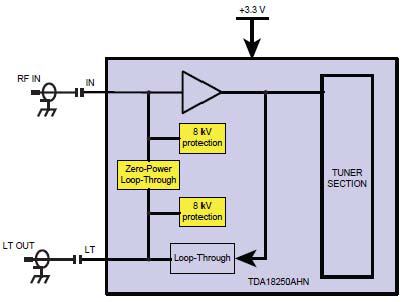NXP Introduces Silicon Tuners with Zero-Power Loop-Through for Cable STBs
Friday, March 16th, 2012
TDA18250A and TDA18260A silicon tuners feature very high levels of integration
EINDHOVEN, Netherlands and SHANGHAI, China — NXP Semiconductors N.V. (NASDAQ: NXPI), the global market leader in silicon TV tuners, today introduced the TDA18250A and TDA18260A – its latest high-performance single and dual silicon tuners for cable set-top-boxes (STBs) covering worldwide digital cable standards. The TDA18250A and TDA18260A are the industry’s first silicon tuners to offer zero-power loop-through, enabling STB manufacturers to comply with the latest EU Ecodesign Directive requirements, which set standby power consumption levels at less than half a watt for simple STBs starting in 2013.

The new generation of cable silicon tuners from NXP is also the industry’s first to fully integrate 8-kV of ESD protection inside the chip, enhancing robustness and further reducing the number of components required. Together, the integrated zero-power loop-through and ESD protection help to save PCB space in the STB, simplifying layout at the critical RF antenna input section, enabling better RF performance, and bringing down the total of bill of materials (BoM) by approximately US 20 cents.
“The TDA18250 is widely known as the ‘silicon tuner of choice’ for the growing cable STB market in China, due to its performance, cost-effectiveness, high level of integration, and proven manufacturing quality. Today, we’re introducing NXP’s next-generation TDA18250A and TDA18260A silicon tuners, which are the industry’s first to enable zero-power loop-through and integrated ESD protection of 8 kV,” said Luca Lo Coco, director, cable product line, NXP Semiconductors. “Delivering compelling performance advantages while consuming less power – and in a smaller PCB space – the TDA18250A and TDA18260A have been designed from the ground up to be the optimal choice for new cable STB development worldwide.”
As stricter EU Ecodesign requirements go into effect, there is growing awareness among manufacturers and consumers about the importance of minimizing standby power consumption. During three hours of daily STB use, the loop-through typically burns through more electricity than the tuner itself. With the TDA18250A and TDA18260A, cable STB power consumption in standby mode is reduced significantly while the loop-through function remains active – even allowing consumers to watch analog TV without switching on the set-top-box. By integrating zero-power loop-through into the silicon tuner itself, NXP is introducing a significant innovation without requiring additional discrete components or introducing additional sensitivity and complexity into cable STB design and manufacturing. Thus, NXP continues to enhance the silicon-tuner advantage over traditional can-type tuners in cost-sensitive applications – eliminating the need for costly external components such as LNAs, SAW filters and baluns; enabling smaller form factors; enabling higher system reliability; and reducing total system costs.
Availability
NXP will showcase the TDA18250A single silicon tuner and TDA18260A dual silicon tuner at CCBN 2012 in Beijing from March 21 – 23 (hall 1B, booth 705). Samples can be ordered from NXP starting in April 2012.
Latest News
- Barb to start reporting TV-set viewing of YouTube channels
- SAT FILM selects multi-DRM from CryptoGuard
- Qvest and ARABSAT to launch OTT streaming platform
- ArabyAds & LG Ad Solutions partner with TVekstra in Turkey
- Freeview NZ satellite TV service to move to Koreasat 6
- Comscore expands YouTube CTV measurement internationally
